I'm working with 3 dimensional coordinates data, which i'm plotting in a scatterplot, i have ~30.000 datapoints, and i've included the first 10 here so that you can reproduce it
library(rgl)
library(plot3D)
library(car)
df <- data.frame(meanX = c(147.34694,
173.89244,
135.73004,
121.93766,
109.72152,
92.53709,
165.46588,
169.77744,
127.01796,
99.34347),
meanY = c(140.40816,
110.99128,
134.56023,
164.18703,
166.04051,
155.97329,
105.29377,
104.42683,
130.17066,
155.99696),
avgDist = c(40.788118,
12.957329,
14.24348,
39.10424,
34.694258,
25.532335,
21.491695,
23.528944,
9.309201,
31.916879))
I've been using the scatter3d function to plot this
scatter3d(x = df$meanX, y = df$meanY, z = df$avgDist, surface = FALSE)
Now my "problem", is that I would like to have a 2d surface with an external image file overlayed onto it at z=0, and as a bonus, if i could project a heatmap/contours from the scatterplot data (meanX and meanY used for the contours) over that image as well, that would be great.
This is the image i'd like to have draped at z = 0:
https://i.stack.imgur.com/BOnnv.png
That image was made with this ggplot:
map.colors <- colorRampPalette(c("green","yellow","red"))
densityPlot <- ggplot(direData, aes(x = meanX, y = ,meanY)) +
stat_density2d(geom="tile", aes(fill=..density.., alpha=sqrt(sqrt(..density..))), contour=FALSE, n=100) +
scale_alpha(range = c(0, 1.0)) + scale_fill_gradientn(colours = map.colors(5)) +
xlim(70,185) + ylim(70,185)
minimap <- readPNG('~/yasp/minimap.png')
densityPlot + annotation_raster(minimap, ymin = 70 ,ymax=185 ,xmin = 70,xmax = 185) +
stat_density2d(geom="tile", aes(fill=..density.., alpha=10*sqrt(..density..)), contour=FALSE, n=100)
Is there any way to do this? I've googled quite a bit for a solution but found no real way of doing this. I don't mind creating the image first in ggplot2 with the heatmap, saving that, and then using that as input for the surface draping, but it would of course be quite cool if it could all be done in one call to plot.

